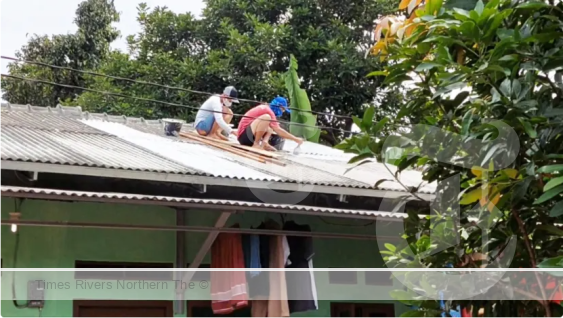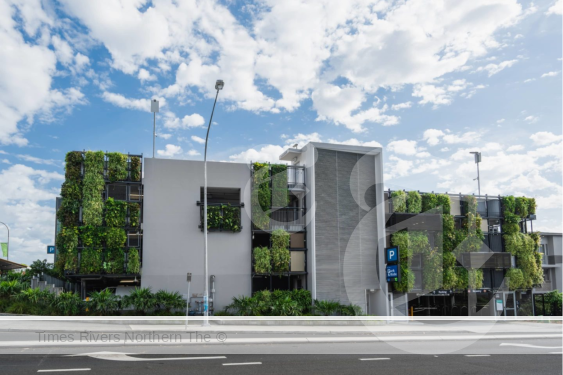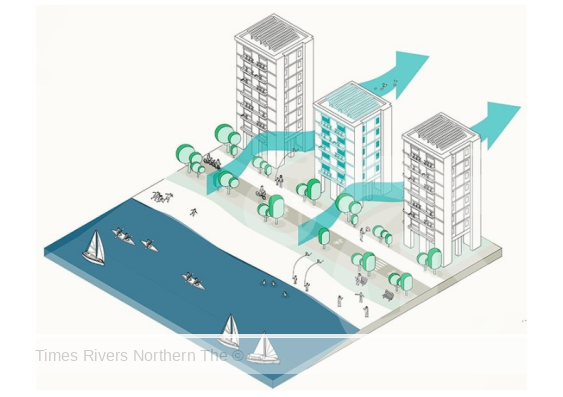Local News
5 ways to cool cities as temperatures soar
Published
11 months agoon
By
Liam
5 ways to cool cities as temperatures soar
UNSW Sydney
As Australia heads into an El Nino summer, UNSW’s Dr Negin Nazarian, an expert in urban climate, explains 5 crucial strategies to keep cities – and people – cooler.
There are several factors that interact when we think about heat in the urban environment.
“First, there’s urban heat itself,” explains Dr Nazarian, “which is the change brought about by urbanisation, buildings, roads, infrastructure and the like. This is often referred to as urban heat island. Then, there’s the impact of climate change, which means that average temperatures globally, as well as in cities, are increasing across the board.
“Finally, climate extremes such as heat waves, are becoming more frequent, longer, and intense due to global warming. And in El Nino years, like now, the risk of climate extremes is also increased. Considering all these drivers, our cities are faced with an increasingly pressing problem of how to manage heat and care for the people living in them. This includes mitigating urban heat in our cities as well as helping our people adapt to them to reduce the negative impacts on their lives.”
1. Cool materials
Urban areas, like cities, are warmer than natural areas – creating what people talk about as the Urban Heat Island effect. And that’s mostly because the types of materials used to create buildings have different properties than natural land cover.
“In the natural environment you have trees, grass and soil, which provide shade, absorb heat and retain water in the environment. However, most materials which create the built environment absorb more heat, trap more radiation, and have no way of retaining moisture for cooling,” explains Dr Nazarian.
To keep cool cities, it’s important for developments to increasingly utilise cool materials that radiate heat, rather than absorbing it. “This can range from light-coloured paints that are suitable on roofs, through to the use of advanced super cool (retroreflective) coatings on pavements. The more advanced ’super cool’ materials reflect most of the striking radiation backwards to the sky, reducing the heat trapped within the urban canopy, which means they won’t be affecting thermal comfort of people in our streets,” says Prof. Nazarian.
Recent developments in some areas of Sydney have seen a proliferation of dark coloured roofs, which accentuates heat accumulation in these new suburbs. “Revisiting the ban on black roofs and requiring the use of light coloured roofing materials by councils would be one way to start to mitigate heat in these green-field developments,” says Prof. Nazarian.
Indonesia’s Cool Roof Project is aiming to create 1 million cool roofs to combat rising temperatures. Cool materials reflect sunlight and reduce the amount of heat absorbed by a building, reducing temperatures inside. Credit: BeCool Indonesia.

Indonesia’s Cool Roof Project is aiming to create 1 million cool roofs to combat rising temperatures. Cool materials reflect sunlight and reduce the amount of heat absorbed by a building, reducing temperatures inside. Credit: BeCool Indonesia.
2. Green Spaces
Increasing urban greenery helps keep cities liveable as temperatures rise.
“Heat mitigation is nuanced,” says Prof Nazarian. “Just planting lots of trees will not cool our cities as we are also facing climate change and its impact on extremes. And most trees only have cooling benefits when they are sufficiently mature, so the impact is medium to long-term impact. However, trees have significant benefits such as providing shade, which reduces our exposure to heat, and helps us endure hotter temperatures. They also have a positive impact on people’s wellbeing, and air quality.”
Parklands, operate in the same way, on a larger scale, creating a ‘thermal oasis’. “They may not fully mitigate urban heat at the city scale, but they provide local cooling and, more importantly, minimise the impact that heat will have on people. Creating more of these thermal oases will help manage the impact of increased urban temperatures,” says Dr Nazarian.
“Green roofs and facades are another good option for cities as they reflect rather than absorb heat,” says Dr Nazarian, “Green facades and roofs also contribute to energy saving of buildings though they are easier to implement in new buildings, where specific water-proofing and irrigation needs can be included in the design.”
Green facades reflect rather than absorb heat, and can also cool through evapotranspiration. Image: Manly Vale Carpark, Sydney / Junglefy.

Green facades reflect rather than absorb heat, and can also cool through evapotranspiration. Image: Manly Vale Carpark, Sydney / Junglefy.
3. Climate-Responsive Urban planning
Urban design and planning decisions have a significant impact on temperature regulation. “Street canyons configured to promote shade and ventilation reduce local air and surface temperatures and improve outdoor thermal comfort, and are key to cooling our cities and people”.
Dr Nazarian also suggests careful consideration of the ratio of impervious surfaces to ‘natural’ and ‘porous’ land needs to take place. And with newer developments, such as those in Western Sydney, the recommended ratio (for instance in the Cool Suburbs Tool used in NSW) is a minimum 50% site perviousness, which can include green roofs and porous pavements.
Moreover, urban design that includes open spaces and positions buildings to facilitate natural ventilation can help dissipate heat in cities. In Sydney’s eastern suburbs, the sea breeze effectively cools the area, while in the western suburbs creating ponds and parks which then cool the breezes that flow through the area can work in the same way.
Singapore’s network of wind corridors exemplifies how thoughtful planning can create a symbiotic relationship between thermal oases and ventilation.
The strategic placement of buildings near blue and green infrastructure, such as in these plans from the Singapore Urban Redevelopment Authority, can allow for improved ventilation in the built environment, resulting in the flow of cooler air into urban areas.

blue and green infrastructure
4. Blue infrastructure
Like green spaces, blue infrastructure, involving water bodies like ponds, rivers and dams, can be a powerful tool for temperature reduction. Integrating water features with green spaces can also help lower the temperatures of surrounding areas. Blue infrastructures can also be strategically placed together with greenery and wind corridors: as breezes blow over bodies of water they are cooled and then transport this cooling effect over nearby areas.
In western Sydney, the Norwest City project combined ponds and green areas with a great cooling effect and deployed a detailed cooling guide to integrate blue and green infrastructure in a multi-use precinct.
In a smaller way, water fountains in shopping areas, parks and boulevards, help cool people when temperatures are high.

“Our cities are faced with an increasingly pressing problem of how to manage heat and care for the people living in them,” says Dr Nazarian. Western Sydney’s Norwest City project integrates blue and green infrastructure to manage heat. (FJC Studio)
5. Reduce human-created heat
The final piece of the puzzle is reducing heat generated by human activities, which is part of a larger project of reducing greenhouse gas emissions. In cities, Dr Nazarian underscores the need to rethink air-conditioning, car use and industrial practices.
“While air-conditioning gives people relief from heat, it simultaneously releases condensation and heat out into the environment, creating more demand for cooling, releasing more heat into the environment in a vicious cycle. Singapore, for instance, is shifting towards more energy-efficient, centralised cooling systems to mitigate localised heat. And some researchers are looking at ways to encourage the increased use of fans, which require far less energy to operate and don’t add heat to the atmosphere.”
There is no silver-bullet to reduce heat in our cities, but cool materials, green spaces, thoughtful urban planning, blue infrastructure and a reduction in human-generated heat will all need to be part of the picture.
For more real estate news, click here.
You may like
-


The Northern Rivers Times Newspaper Edition 223
-


The Northern Rivers Times, Edition 221
-


How to Harvest and Dry Herbs for Optimal Flavour and Use
-


2025 Smart #5 Electric SUV Revealed: The Future of Outdoor Adventure
-


Grim Warning for Aussie Homeowners: Rate Relief Still Distant
-


Urgent Action Needed: Community is Both the Challenge and Solution for People with Dementia

Get Your Garden Ready for Warmer Weather
By Liam Jennings
As the days grow longer and the temperatures rise, gardeners everywhere feel the urge to head outside and prepare their gardens for the warmer months. Spring is the perfect time to give your outdoor space a fresh start, whether you’re nurturing a vegetable patch, tending to a flower garden, or simply beautifying your yard. Preparing your garden now ensures that it will thrive in the coming season and helps set the stage for a bountiful summer.
Here are some essential tips for getting your garden ready for the warmer weather.
Clean Up and Clear Out
Before you can plant new seeds or tend to your perennials, you need to clear away the remnants of winter. Start by removing any dead plants, weeds, and debris that have accumulated over the colder months. Dead leaves, fallen branches, and spent annuals can harbor pests and diseases, so it’s important to clear them out to create a clean, healthy environment for new growth.
Once the garden beds are clear, take a moment to prune your perennials and shrubs. Deadheading spent blooms and cutting back dead stems encourages healthier growth and prevents the plant from wasting energy. Pruning is especially important for rose bushes, hydrangeas, and other flowering plants that benefit from a good trim before the growing season begins.
Revitalise the Soil
After a season of dormancy, your garden’s soil needs attention. The cold, wet conditions of winter can leave soil compacted and depleted of nutrients. Start by loosening the soil in your garden beds with a fork or spade, which helps improve aeration and drainage. You might also want to add organic matter like compost, leaf mould, or well-rotted manure to improve soil structure and replenish nutrients.
Testing your soil’s pH can also be a good idea, as certain plants thrive in more acidic or alkaline conditions. If your soil is too acidic, adding lime can help balance it, while sulphur can lower the pH if it’s too alkaline.
Fertilise Early for a Strong Start
Fertilising in spring gives your plants the nutrients they need to grow vigorously throughout the warmer months. Different plants have varying nutritional needs, so consider using a slow-release fertiliser for general garden use, or choose a specific fertiliser designed for the types of plants you’re growing.
Organic fertilisers like compost or seaweed extracts are a great way to feed your plants while also improving the soil’s health. For flower gardens, you can add a balanced fertiliser that provides nitrogen, phosphorus, and potassium to encourage lush foliage and blooms. For vegetable gardens, opt for a fertiliser rich in nitrogen, which promotes leaf and stem growth, while phosphorus helps with root and fruit development.
Planting and Sowing
Spring is the ideal time to plant, whether you’re starting from seeds or transplanting seedlings. Hardy annuals and cool-weather vegetables like peas, spinach, and lettuce can be planted early in the season, while more tender plants like tomatoes and peppers should wait until the soil warms up.
For flower gardens, now is the perfect time to plant summer bulbs such as dahlias, gladiolus, and lilies. These plants will produce stunning blooms as the season progresses, adding vibrant colour and texture to your garden. Be mindful of the growing conditions of each plant and ensure that they are placed in the right spot—sun-loving plants should go in sunny locations, while shade-tolerant varieties should be placed in more sheltered areas.
If you’ve been dreaming of a herb garden, spring is the perfect time to start planting your favourite herbs. Parsley, basil, rosemary, and thyme thrive in warm weather and will be ready to harvest in the summer months.
Mulching Matters
Mulching is one of the best ways to protect your garden from the heat of the summer while helping your plants thrive. Adding a layer of organic mulch around your plants helps retain moisture, suppress weeds, and regulate soil temperature.
Choose a mulch that suits your garden’s needs—compost, wood chips, straw, or bark mulch are all excellent choices. Apply a 5-7cm layer of mulch around your plants, being careful not to pile it too close to the stems or trunks, as this can cause rot.
Mulching also helps improve the soil over time as it breaks down, adding valuable organic matter back into your garden beds.
Irrigation Preparation
Warmer weather means your plants will need more water to stay hydrated. Spring is the perfect time to check your irrigation system or hose setup to ensure it’s working efficiently. Make sure your hoses are free from leaks and consider setting up a drip irrigation system to deliver water directly to the roots of your plants, where it’s needed most.
Watering early in the morning is best during warmer months as it allows the plants to absorb moisture before the heat of the day evaporates it. Aim for deep, infrequent watering to encourage deeper root growth.
Pest and Disease Control
With warmer weather comes an increase in pests and diseases. Keep an eye out for common garden pests like aphids, slugs, and snails, which can cause damage to tender new shoots. Consider using organic pest control methods, such as introducing beneficial insects like ladybugs, using neem oil, or setting up physical barriers like copper tape to deter slugs.
Inspect your plants regularly for signs of disease such as powdery mildew, rust, or leaf spot. Early detection is key to preventing the spread of disease, and removing affected foliage can help keep the problem under control.
Plan for Growth
As your garden springs to life, don’t forget to plan for future growth. Staking tall plants early will prevent them from flopping over as they grow, and ensuring enough space between plants allows for proper air circulation, which can help prevent disease.
Get out into the garden!
By giving your garden the care it needs now, you’ll set yourself up for a thriving, beautiful space all summer long. Whether you’re growing food, flowers, or simply enhancing your landscape, a little preparation in spring can make all the difference as the weather warms.
Gardening
Shredded Rubber Mulch in Your Garden: Is it any good?
Published
3 days agoon
15 October 2024By
Liam
Shredded Rubber Mulch in Your Garden: Is it any good?
By Liam Jennings
Gardeners have experimented with various mulching materials over the years. Each offers its own set of benefits and drawbacks, with most eventually breaking down, fading, or blending into the soil. However, when rubber mulch—made from recycled tires—entered the market, it promised a long-lasting, low-maintenance solution that wouldn’t require reapplication over time. But like any product, shredded rubber mulch comes with both pros and cons.
What is Shredded Rubber Mulch?
Shredded rubber mulch is primarily made from recycled tires and comes in several forms, including crumbs, shreds, nuggets, and sheets. It’s widely used in areas like playgrounds, roadways, and running tracks due to its durability. When compared to traditional mulches, rubber mulch tends to be more expensive upfront but boasts a significantly longer lifespan, potentially saving money in the long run.
The Benefits of Rubber Mulch
- Long-lasting Durability: One of the main advantages of rubber mulch is its longevity. Unlike organic materials, it does not decompose or break down over time, meaning it essentially remains in your garden indefinitely. Provided it’s not affected by extreme conditions like flooding or heavy erosion, rubber mulch will stay in place with little need for maintenance.
- Moisture Conservation: Rubber mulch acts as a barrier that helps conserve soil moisture. Rain and snow can still penetrate the mulch and reach the soil, but the rubber prevents it from evaporating too quickly. This helps maintain moisture in the soil for longer, especially in hot or dry climates.
- Colour Retention: Rubber mulch is available in a variety of colours, which tend to hold up well over time. Unlike organic mulches that may fade after a season or two due to sun and rain exposure, rubber mulch maintains its colour for years, providing a long-lasting, uniform appearance.
- Environmentally Friendly Recycling: Since rubber mulch is made from recycled tires, it helps repurpose waste that would otherwise end up in landfills or oceans. It provides a practical and sustainable way to create a useful product out of discarded materials.
- Effective Weed Barrier: When applied thickly, rubber mulch can be an excellent barrier against weeds. Due to its lack of pores and ability to retain little moisture, weeds struggle to take root. Seeds may start to germinate, but they typically die off quickly due to the absence of moisture.
- Easy to Transport: Unlike heavier options like rocks or pebbles, rubber mulch is dense but relatively lightweight, making it easier to transport in large quantities.
The Downsides of Rubber Mulch
- No Benefit to Soil Health: One of the biggest drawbacks of rubber mulch is that it does not enhance soil health. While organic mulches decompose over time, adding valuable nutrients and organic matter to the soil, rubber mulch is completely inert. It doesn’t break down, meaning your soil doesn’t get the same nutrient boost that organic mulches provide.
- Heat Retention: Rubber mulch is known to absorb and retain heat, which can become problematic in certain climates. On hot, sunny days, it can trap heat, which may damage delicate plants and even burn the paws of animals walking on it. In extreme conditions, rubber mulch has even been known to combust, releasing harmful toxins into the atmosphere and the surrounding soil.
- Difficult to Remove: Once you’ve decided to use rubber mulch, it can be difficult to get rid of if you ever change your mind. Unlike organic mulch that breaks down and becomes part of the soil, rubber mulch remains intact. Removing every last piece can be a tedious task, and disposing of it in bulk requires finding a proper recycling or disposal facility.
The Verdict
Rubber mulch has its place in certain landscapes, particularly in areas where little to no planting occurs, such as pathways, playgrounds, or non-vegetated spaces. Its durability, weed suppression, and moisture retention make it appealing for these uses. However, for traditional garden beds or areas where soil health and plant growth are priorities, rubber mulch may not be the best option.
While it may seem convenient, the long-term consequences of using rubber mulch in a garden should not be overlooked. Its inability to improve soil quality, potential to overheat, and difficulty in removal are significant drawbacks that need careful consideration. Before deciding to incorporate shredded rubber mulch into your garden, weigh the pros and cons thoroughly to ensure it’s the right choice for your space.
Local News
The latest edition of The Northern Rivers Times (Edition 222)
Published
1 week agoon
11 October 2024By
JeffG
The latest edition of The Northern Rivers Times (Edition 222) delivers a wealth of stories highlighting key developments and community events across the region:
• Grafton Cathedral Restoration Nearing Completion: A significant $850,000 restoration project on Grafton’s historic cathedral is almost finished, preserving the town’s heritage for future generations.
• Grafton Shopping World to Receive a Fresh New Look: A revitalization of Grafton’s main shopping precinct is on the horizon, bringing a modern upgrade to the beloved retail centre.
• Career Opportunities in the Meat Industry: Casino Food Co-op promotes career pathways in the meat industry, encouraging locals to consider opportunities in this growing sector.
• Northern Rivers Health Workers Recognized: Local health professionals are in the spotlight as they become finalists for prestigious awards, acknowledging their dedication and service.
• New and Familiar Faces in Northern Rivers Councils: Recent council elections have brought a mix of both new and returning councillors across the region, shaping the future of local governance.
• Celebrating Young Athletes: Federal MP Kevin Hogan shines a light on the region’s young sportspeople, commending their dedication and achievements.
• Breast Screening Overdue for 40% of Women in Northern NSW: A significant number of women in the region are overdue for vital breast screenings, raising concerns for health advocates.
• Tweed Trials New Container Deposit and Collection Scheme: A new initiative to trial container deposit systems in popular parks within Tweed aims to enhance recycling and reduce litter.
• Mental Health Struggles Revealed: Beyond Blue’s new data highlights the challenges many Australians face, with people waiting years before seeking mental health support.
• NSW Trout Season Opens: Fishing enthusiasts gear up for the start of the NSW trout season, kicking off on Saturday, October 5.
• Restored Hannah Cabinet Returns to Lismore: The intricate and historic Hannah Cabinet makes its way back to Lismore after careful restoration, where it will again be on display.
• New Principals Appointed in Murwillumbah Schools: As part of the return to four distinct schools in Murwillumbah, new leadership has been appointed to guide these educational institutions.
• Makers Hub Workshop Announcement: An upcoming workshop at the Makers Hub promises hands-on learning and creative experiences for local artisans.
• Living Memory: North Lismore Stories: A special collection of stories and portraits will celebrate the history and culture of North Lismore, highlighting the strength of its community.
• Warning Over High-Dose MDMA Tablets: Authorities issue a caution regarding dangerous high-dose MDMA (ecstasy) circulating in NSW.
• Byron Bay Welcomes Australia’s First Hydrothermal Wellness Bathhouse: In a wellness tourism milestone, Byron Bay will host the country’s first medical-grade hydrothermal bathhouse, opening in October.
• Lismore Regional Gallery Reopens: Following extensive restorations, the Lismore Regional Gallery is now open to the public, offering a rejuvenated space for the arts.
• Laith McGregor Wins 2024 Jacaranda Drawing Award: Acclaimed artist Laith McGregor takes home the coveted Jacaranda Acquisitive Drawing Award for 2024, celebrating excellence in the arts.
• NSW Government Simplifies Cemetery and Crematorium Regulations: Red tape has been cut, making it easier for cemeteries and crematoriums in NSW to operate more efficiently.
• Pay Parking Commences in Brunswick Heads: Visitors to Brunswick Heads will now face pay parking regulations, a new policy designed to manage traffic and parking demand.
• “Grounded” Exhibition Showcases Bundjalung Cultural Knowledge: A new art exhibition titled GROUNDED celebrates Bundjalung cultural heritage and creative well-being.
• New Team of Councillors for Tweed: The Tweed Shire confirms its new team of councillors, ready to lead the region into the future.
• Tweed Regional Museum Wins Top Prize for “Supertunic” Exhibition: The Tweed Regional Museum takes home a prestigious award for its groundbreaking exhibition “Supertunic,” showcasing creative excellence and community engagement.
This edition captures a vibrant mix of community milestones, health initiatives, cultural celebrations, and local governance updates across Northern Rivers.
NRTimes Online
ADVERTISEMENT



Early entry to university – Opinion Piece by Prue Car

GROUNDED: A New Exhibition Celebrating Bundjalung Cultural Knowledge and Creative Wellbeing

Laith McGregor Wins 2024 Jacaranda Acquisitive Drawing Award

Living Memory: Stories and portraits celebrating North Lismore

Makers Hub Workshop Coming Up!

Mullum pool remains temporarily closed

A NEW TWEED HEADS

Toyota Supra: Get Ready For A Fully Electric Version In 2025

Northern Rivers Local Health District COVID-19 update

Northern Rivers COVID-19 update

Fears proposed residential tower will ‘obliterate’ Tweed neighbourhood’s amenity and charm

COVID-19 Vaccination Clinic now open at Lismore Square
National News Australia


Call for more mates to support Port Macquarie’s Sailability
Call for more mates to support Port Macquarie’s Sailability Vision available: https://tinyurl.com/mrz9nhz7 The Port Macquarie community group, Sailability, is calling...


Teen charged with multiple property offences in Cowra – Operation Regional Mongoose
Teen charged with multiple property offences in Cowra – Operation Regional Mongoose Tuesday, 24 September 2024 02:01:49 PM A teen...


Man charged after allegedly threatening police – Bathurst
Man charged after allegedly threatening police – Bathurst Tuesday, 24 September 2024 12:58:23 PM A man is due to face...
Latest News
-

 Tweed Shire News2 years ago
Tweed Shire News2 years agoA NEW TWEED HEADS
-

 Motoring News2 years ago
Motoring News2 years agoToyota Supra: Get Ready For A Fully Electric Version In 2025
-

 COVID-19 Northern Rivers News3 years ago
COVID-19 Northern Rivers News3 years agoNorthern Rivers Local Health District COVID-19 update
-

 COVID-19 Northern Rivers News3 years ago
COVID-19 Northern Rivers News3 years agoNorthern Rivers COVID-19 update
-

 Northern Rivers Local News3 years ago
Northern Rivers Local News3 years agoFears proposed residential tower will ‘obliterate’ Tweed neighbourhood’s amenity and charm
-

 Health News3 years ago
Health News3 years agoCOVID-19 Vaccination Clinic now open at Lismore Square
-

 COVID-19 Northern Rivers News3 years ago
COVID-19 Northern Rivers News3 years agoLismore Family Medical Practice employee close contact
-

 NSW Breaking News3 years ago
NSW Breaking News3 years agoVale: Former NSW prison boss Ron Woodham








